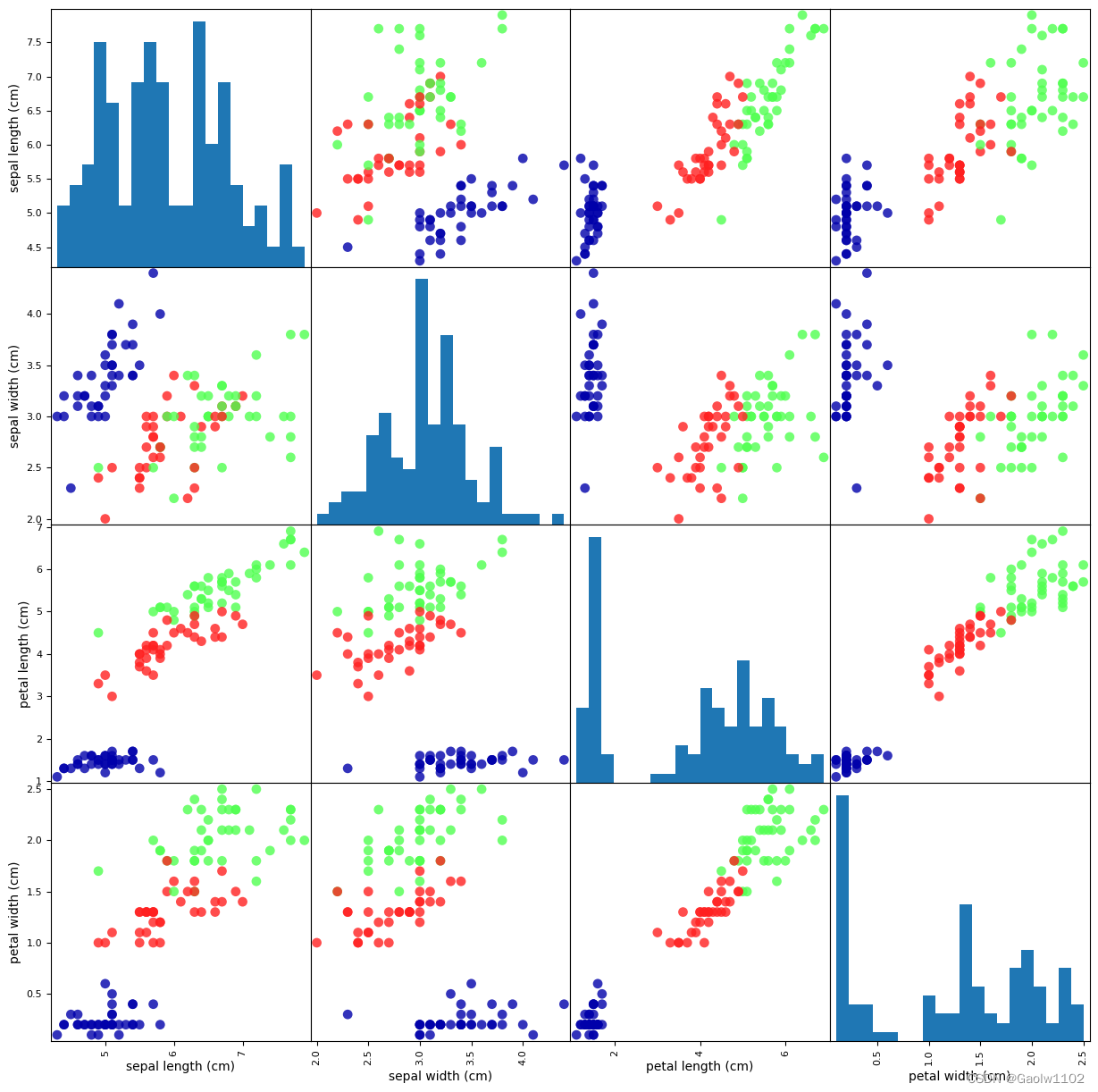鸢尾花分类(代码实现)----python机器学习基础教程
鸢尾花自动分类、机器学习、Python
·
文章目录
前言
此案例是《python机器学习基础教程》第一章的入门案例,自己上手敲了一遍并稍作理解,如有不解,请在评论区留言,欢迎共同探讨。
Step1:获取数据集并分析数据集
from IPython.display import display
from sklearn.datasets import load_iris # 加载sklearn默认的数据集
# 获取 iris 数据集内容
iris_dataset = load_iris()
数据中的内容如下
{'data': array([[5.1, 3.5, 1.4, 0.2],
[4.9, 3. , 1.4, 0.2],
[..................]
[6.7, 3. , 5.2, 2.3],
[6.3, 2.5, 5. , 1.9],
[6.5, 3. , 5.2, 2. ],
[6.2, 3.4, 5.4, 2.3],
[5.9, 3. , 5.1, 1.8]]), # 数据信息
'target': array([0, 0, 0, 0, 0, 0, 0, 0, 0, 0, 0, 0, 0, 0, 0, 0, 0, 0, 0, 0, 0, 0,
0, 0, 0, 0, 0, 0, 0, 0, 0, 0, 0, 0, 0, 0, 0, 0, 0, 0, 0, 0, 0, 0,
0, 0, 0, 0, 0, 0, 1, 1, 1, 1, 1, 1, 1, 1, 1, 1, 1, 1, 1, 1, 1, 1,
1, 1, 1, 1, 1, 1, 1, 1, 1, 1, 1, 1, 1, 1, 1, 1, 1, 1, 1, 1, 1, 1,
1, 1, 1, 1, 1, 1, 1, 1, 1, 1, 1, 1, 2, 2, 2, 2, 2, 2, 2, 2, 2, 2,
2, 2, 2, 2, 2, 2, 2, 2, 2, 2, 2, 2, 2, 2, 2, 2, 2, 2, 2, 2, 2, 2,
2, 2, 2, 2, 2, 2, 2, 2, 2, 2, 2, 2, 2, 2, 2, 2, 2, 2]), # 数据对应的标签信息
'frame': None,
'target_names': array(['setosa', 'versicolor', 'virginica'], dtype='<U10'), # 标签的名称
'DESCR': '.. _iris_dataset:.........', #该数据集的描述
'feature_names': ['sepal length (cm)','sepal width (cm)','petal length (cm)','petal width (cm)'], # 特征名称
'filename': 'iris.csv', # 文件名称
'data_module': 'sklearn.datasets.data'
}
分析data数据集的类型、形状及数据大小
print(type(iris_dataset['data']))
print(iris_dataset['data'].shape)
运行结果
<class 'numpy.ndarray'>
(150, 4)
分析target标签的类型、形状及数据大小
print(type(iris_dataset['target']))
print(iris_dataset['target'].shape)
运行结果
<class 'numpy.ndarray'>
(150,)
target_names表示标签对应的鸢尾花名称,分别为 setosa、versicolor、virginica
feature_names 表示对数据特征的名称,分别为 sepal length (cm)、sepal width (cm)、petal length (cm)、petal width (cm)
DESCR、filename、data_module 表示对于数据集的具体描述,暂不重要
Step2:拆分数据集(dataset)为训练集(train)与测试集(test)
其中 X_train,y_train分别为训练集的数据与标注;X_test,y_test分别为测试集的数据与标注
拆分比例一般为 : 0.75 : 0.25
from sklearn.model_selection import train_test_split
# 其中X_train, y_train表示训练集的数据与标签, X_test,y_test表示测试集的数据与标签,返回值均为 numpy 数组
X_train, X_test, y_train, y_test = train_test_split(iris_dataset['data'], iris_dataset['target'], random_state=0)
print('X_train shape: {}'.format(X_train.shape))
print('y_train shape: {}'.format(y_train.shape))
print('X_test shape: {}'.format(X_test.shape))
print('y_test shape: {}'.format(y_test.shape))
运行结果
X_train shape: (112, 4)
y_train shape: (112,)
X_test shape: (38, 4)
y_test shape: (38,)
Step3:观察数据图(以pandas库生成数据图表)
import pandas as pd
import mglearn
# 利用 X_train中的数据创建 DataFrame
# 利用 iris_dataset.feature_names中的字符串对数据列进行标记
iris_dataframe = pd.DataFrame(X_train, columns=iris_dataset['feature_names'])
# 利用DataFrame创建散点图矩阵,按 y_train 着色
grr = pd.plotting.scatter_matrix(iris_dataframe, c=y_train, figsize=(15,15), marker='o',
hist_kwds={'bins':20}, s=60, alpha=.8, cmap=mglearn.cm3)
运行结果(根据分布特点可使用knn算法)

Step4:构建模型训练数据----K近邻算法
from sklearn.neighbors import KNeighborsClassifier
knn = KNeighborsClassifier(n_neighbors=1) #设置邻点个数为 1
knn.fit(X_train, y_train) #通过训练集构建模型
运行结果
KNeighborsClassifier(n_neighbors=1)
Step5:输入数据做出预测
import numpy as np
X_new = np.array([[5, 2.9, 1, 0.2]])
print('X_new shape: {}'.format(X_new.shape))
运行结果(待输入模型的数据)
X_new shape: (1, 4)
prediction = knn.predict(X_new)
print('The predict is: {}'.format(iris_dataset['target_names'][prediction]))
运行结果
The predict is: ['setosa']
预测正确
Step6:评估模型
y_pre = knn.predict(X_test)
print('Test set predictions:\n {}'.format(y_pre))
Test set predictions:
[2 1 0 2 0 2 0 1 1 1 2 1 1 1 1 0 1 1 0 0 2 1 0 0 2 0 0 1 1 0 2 1 0 2 2 1 0
2]
print(y_test)
[2 1 0 2 0 2 0 1 1 1 2 1 1 1 1 0 1 1 0 0 2 1 0 0 2 0 0 1 1 0 2 1 0 2 2 1 0
1]
可观测得出,该两个列表仅最后一个label不同。
print('Test set score: {:.2f}'.format(np.mean(y_pre==y_test)))
手动评估结果
Test set score: 0.97
print(knn.score(X_test,y_test))
算法评估结果
0.9736842105263158
更多推荐
 已为社区贡献3条内容
已为社区贡献3条内容









所有评论(0)